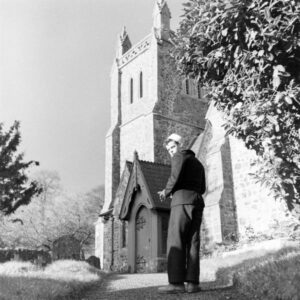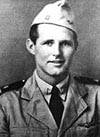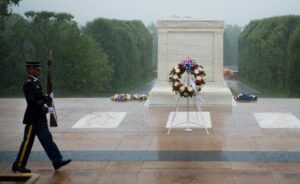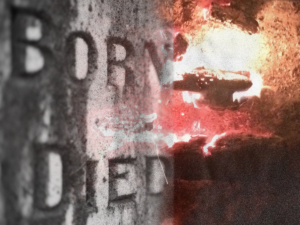 Each year America celebrates the start of the summer season by remembering those who have fallen during the conflicts in which it has engaged. Unfortunately, each year there are more men and women to remember. As I noted in past posts, the day was officially proclaimed on 5 May 1868 by General John Logan, national commander of the Grand Army of the Republic, in his General Order No. 11, and was first observed on 30 May 1868, when flowers were placed on the graves of Union and Confederate soldiers at Arlington National Cemetery. Each year ceremonies remembering fallen soldiers, sailors, Marines, and airmen are held around the world in places where they fought and died. One such ceremony takes place in a small English village in Devonshire called Dunkeswell. There, in a lovely little Anglican church built in 1868, a memorial service is held and wreaths are laid in front of plaques honoring those who died while serving at the small airfield just outside of town. The attached image was taken of the Church of Saint Nicolas back in 1944. Yesterday marked the 66th service honoring the war dead.
Each year America celebrates the start of the summer season by remembering those who have fallen during the conflicts in which it has engaged. Unfortunately, each year there are more men and women to remember. As I noted in past posts, the day was officially proclaimed on 5 May 1868 by General John Logan, national commander of the Grand Army of the Republic, in his General Order No. 11, and was first observed on 30 May 1868, when flowers were placed on the graves of Union and Confederate soldiers at Arlington National Cemetery. Each year ceremonies remembering fallen soldiers, sailors, Marines, and airmen are held around the world in places where they fought and died. One such ceremony takes place in a small English village in Devonshire called Dunkeswell. There, in a lovely little Anglican church built in 1868, a memorial service is held and wreaths are laid in front of plaques honoring those who died while serving at the small airfield just outside of town. The attached image was taken of the Church of Saint Nicolas back in 1944. Yesterday marked the 66th service honoring the war dead.
The airfield was built during the Second World War (from 1941 to 1943) for the British Royal Air Force and named RAF Dunkeswell. According to Wikipedia, “the station was originally planned as a RAF Fighter Command, then a RAF Coastal Command airfield, but was transferred for use by American units. It was first used by the American United States Army Air Force Antisubmarine Command 479th Antisubmarine Group as a base of operations to fly antisubmarine missions over the Bay of Biscay using specialized B-24 Liberator bombers from August until November 1943. In November the United States Army Air Force turned over the antisubmarine mission to the United States Navy and its Liberators were reassigned to Navy Patrol Bomber Squadron VPB-103, Fleet Air Wing 7, which continued aerial antisubmarine operations from the station. This was the first United States Navy unit to train with the RAF, later followed by VB-105 and VB-110. The Naval antisubmarine squadrons moved to RAF Upottery in November 1944. With the departure of the Americans, the RAF used the airfield from August 1945 to April 1946 for ferrying aircraft to the Middle East by 16 Ferry Unit, RAF Transport Command. After September 1946 the station was put on care and maintenance status until the end of 1948, when it was sold by the Ministry of Defence.”
In addition to the annual memorial service, there is a Dunkeswell Memorial Museum whose motto is: “Many returned home, some stayed forever, none will be forgotten.” The museum “is dedicated to all the Veterans of United States Fleet Air Wing 7 and RAF personnel who served on the only American Navy air base commissioned on UK soil during World War II.” RAF Dunkeswell may well have ended up as an obscure footnote in history had it not been for one of the men whose name can be found on the plaque at the back of the town’s church. That man was Lieutenant Joseph P. Kennedy, Jr., USN, older brother of President John F. Kennedy. The following information about Lt. Kennedy comes from a biographical sketch found on the website of The Joseph P. Kennedy, Jr., Foundation:
“Joseph P. Kennedy, Jr., … attended Harvard Law School, but left before his final year to volunteer as a Navy flier. Awarded his wings in May 1942, he flew Caribbean patrols and in September 1943 was sent to England with the first naval squadron to fly B-24’s with the British Naval Command. His military service, which ended with his death on August 12, 1944, was described as follows by his brother, John F. Kennedy:
‘His squadron, flying in the bitter winter over the Bay of Biscay, suffered heavy casualties, and by the time Joe had completed his designated number of missions in May, he had lost his former co-pilot and a number of close friends. Joe refused his proffered leave and persuaded his crew to remain on for D-day. They flew frequently during June and July, and at the end of July they were given another opportunity to go home. He felt it unfair to ask his crew to stay on longer, and they returned to the United States. He remained. For he had heard of a new and special assignment for which volunteers had been requested which would require another month of the most dangerous type of flying. … It may be felt, perhaps, that Joe should not have pushed his luck so far and should have accepted his leave and come home. But two facts must be borne in mind. First, at the time of his death, he had completed probably more combat missions in heavy bombers than any other pilot of his rank in the Navy and therefore was preeminently qualified, and secondly, as he told a friend early in August, he considered the odds at least fifty-fifty, and Joe never asked for any better odds than that.’
“The Secret mission on which he lost his life was described by a fellow officer after it was declassified:
‘Joe, regarded as an experienced Patrol Plane Commander, and a fellow-officer, an expert in radio control projects, was to take a ‘drone’ Liberator bomber loaded with 21,170 pounds of high explosives into the air and to stay with it until two ‘mother’ planes had achieved complete radio control over the ‘drone.’ They were then to bail out over England; the ‘drone,’ under the control of the ‘mother’ planes, was to proceed on the mission which was to culminate in a crash-dive on the target, a V-2 rocket launching site in Normandy. The airplane … was in flight with routine checking of the radio controls proceeding satisfactorily, when at 6:20 p.m. on August 12, 1944, two explosions blasted the ‘drone’ resulting in the death of its two pilots. No final conclusions as to the cause of the explosions has ever been reached.’
“Joe was posthumously awarded the Navy Cross … and also the Air Medal … In 1946 a destroyer, the USS Joseph P. Kennedy, Jr., destroyer No. 850, was launched at the Fore River shipyards as the Navy’s final tribute to a gallant officer and his heroic devotion to duty.”
Lt. Kennedy was among the Second World War’s most noted casualties; but, he is mourned neither more nor less than others who died in the service of their country. We cannot sufficiently honor their sacrifice. We can only carry on the effort to secure the liberty and peace for which they died. The late President Ronald Reagan once said, “A people free to choose will always choose peace.” The greatest Memorial Day tribute we could give fallen heroes is a world at peace. Unfortunately, that day looks far off and remains more of a hope than a possibility.





